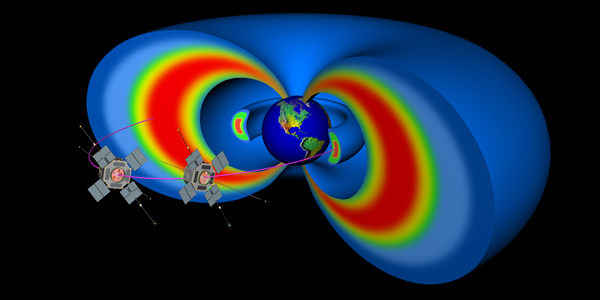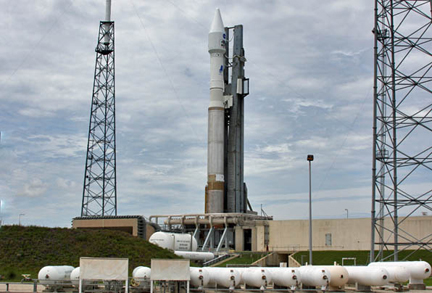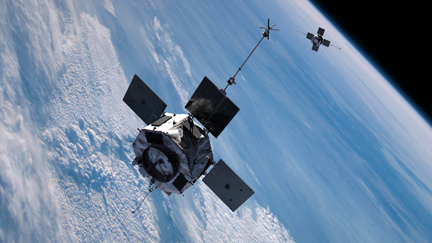Twin satellites poised for radiation belt mission
08/23/2012 03:42 PM Filed in: Space News | Space Science
By WILLIAM HARWOOD
CBS News
KENNEDY SPACE CENTER, FL--Two heavily shielded 1,400-pound satellites set for launch early Friday will fly in tandem through Earth's energetic Van Allen radiation belts in a two-year $686 million mission to probe the structure of the huge doughnut-shaped zones, how they are affected by titanic solar storms and the threat they pose to astronauts and costly spacecraft.
In so doing, the twin Radiation Belt Storm Probes are expected to shed light on fundamental physics governing the behavior of fields and particles across the cosmos and on the more immediate impacts of space weather, which can cripple satellites, disrupt power grids, scramble communications and interfere with Global Positioning System navigation beacons.
"We've been waiting for this mission for decades," said Project Scientist Richard Fitzgerald of the Johns Hopkins University Applied Physics Laboratory. "The Van Allen belts were discovered in 1958 and since that time, we know something about the radiation belts but not enough. This mission is designed to really understand the whole solar interaction with the radiation belts and understand why they are excited (by the sun) and sometimes, why they're not."
Said Nicola Fox, the deputy project scientist at APL: "The difficult thing for us to work out is why they're changing, why they change at different times to seemingly similar drivers. We know that variations in the sun create strong geomagnetic storms here at Earth. But what we don't understand is how we really, truly respond to them."
"It's almost like making a cake," she told reporters earlier this week. "You know all the ingredients, but you're not quite sure of the proportions of each piece."
A United Launch Alliance Atlas 5 rocket carrying both Radiation Belt Storm Probes -- RBSP -- spacecraft was poised for liftoff from launch complex 41 at the Cape Canaveral Air Force Station at 4:07 a.m. EDT (GMT-4), the opening of a 20-minute launch window. The flight was delayed one day to give engineers time to make sure a problem found in another rocket was not an issue.
Assuming an on-time takeoff, the first RBSP spacecraft will be released into its planned orbit one hour and 18 minutes after launch, followed 13 minutes later by the second.
The identical solar-powered satellites, built and operated by APL, will fly in slightly different orbits tilted 10 degrees to the equator with high points, or apogees, around 19,000 miles and low points, or perigees, around 315 miles. The spacecraft will periodically lap each other, passing as close as 100 miles and as far apart as 24,000 miles or so.
The RBSP satellites will fly through both main radiation belts, using a suite of instruments to precisely measure the fields and particles, how the belts expand and contract as solar storms pass through and how they change over time.
"That spatial and temporal data can be combined with data from another spacecraft ... called the Solar Dynamics Observatory, which was launched in early 2010, so that we can at one time see the solar impulse into the Earth's environment and radiation belts and then watch over time and space how those belts morph or change and respond," said Mike Luther, NASA's deputy science chief.
"At the same time, the spacecraft will also contribute operationally as their data will be delivered in near real time to users all over the world so that those users can protect sensitive ground-based as well as space-based assets."
Two spacecraft are needed to distinguish between local or transient events and those that are more widespread.
"If you imagine sitting on a life raft in the ocean and you suddenly go down and come up again, you don't know very much about what caused you to go down and come up," Fox said. "If you have a friend who is sitting on a life raft a little way away, you can say well, did we both go down and up at the same time? In which case it's a big-scale feature like a tsunami. Did one of us go down and then the other one? How far apart did we see that feature, did it grow, did it shrink? And you can really start to look at the global dynamics of what's happening in the radiation belts."
Discovered in 1958 by the first U.S. science satellite, Explorer 1, the Van Allen radiation belts are defined by Earth's magnetic field, which traps electrically charged particles from from deep space and the sun, which periodically blasts torrents of high-energy particles toward Earth.
Positively charged protons tend to get trapped in an inner belt that begins at the top of the atmosphere and extends out to about 4,000 miles. Negatively charged electrons populate a thicker outer belt that begins at an altitude of about 8,000 miles and extends through 26,000 miles. Powerful electric currents flow as the particles interact with the magnetic field, which can accelerate them to near light speed.
Where magnetic field lines plunge into the atmosphere near the north and south poles, particles spiraling inward can bounce back out or crash into the upper atmosphere producing spectacular auroral displays. The RBSP satellites are equipped with eight heavily shielded, state-of-the-art instruments that can precisely measure field strength and particle energies.
"We need eight (instruments) because we're measuring across this huge energy range," said Harlan Spence, a principal investigator from the University of New Hampshire. "From particles that are very, very low energy -- in our units we talk about going down to one electron volt, very low energy -- to particles that are moving near the speed of light at billions of electron volts. A huge energy range we have to cover. We're looking at protons, electrons, helium and oxygen ions."
The picture is especially complex, he said, because "charged particles in the presence of a magnetic field have different motions. There's a gyro motion, the particle will spiral around, gyrate around a magnetic field (line). In a magnetic field geometry that's narrowing at different locations, they can bounce between these reflection points and lastly, they can drift across the field lines."
Uncounted trillions of particles are trapped in the radiation belts, "all moving in these complicated directions," Spence said. "Part of our job is to (measure) the directionality. Why do we measure them? Killer electrons are space weather's villains. They are fantastic things to observe from the point of view of the physics, there's this cosmic accelerator literally above our heads that's taking these particles and bringing them near to the speed of light. But they also can inflict damage."
RBSP, Spence said, "will go right to the scene of the crime to watch the radiation belt particles in action, along with their accomplices. What is it that accelerates these particles? It's the electric and magnetic fields that determine their quote-unquote bad behavior."
Along with accelerating charged particles, causing the Van Allen belts to expand and become more powerful, the electric and magnetic fields that define the belts are what cause "the radiation belts to decrease, they can cause particles to hit the atmosphere so they're lost and never come back," said Craig Kletzing, a principal investigator at the University of Iowa.
"So by measuring these fields, we have the other half of the puzzle, we have the particles and then we have the fields that cause them to change their behavior," he said.
CBS News
KENNEDY SPACE CENTER, FL--Two heavily shielded 1,400-pound satellites set for launch early Friday will fly in tandem through Earth's energetic Van Allen radiation belts in a two-year $686 million mission to probe the structure of the huge doughnut-shaped zones, how they are affected by titanic solar storms and the threat they pose to astronauts and costly spacecraft.
In so doing, the twin Radiation Belt Storm Probes are expected to shed light on fundamental physics governing the behavior of fields and particles across the cosmos and on the more immediate impacts of space weather, which can cripple satellites, disrupt power grids, scramble communications and interfere with Global Positioning System navigation beacons.
"We've been waiting for this mission for decades," said Project Scientist Richard Fitzgerald of the Johns Hopkins University Applied Physics Laboratory. "The Van Allen belts were discovered in 1958 and since that time, we know something about the radiation belts but not enough. This mission is designed to really understand the whole solar interaction with the radiation belts and understand why they are excited (by the sun) and sometimes, why they're not."
 |
| NASA's twin Radiation Belt Storm Probe satellites will study the Van Allen radiation belts over the course of a two-year mission. (Credit: NASA) |
Said Nicola Fox, the deputy project scientist at APL: "The difficult thing for us to work out is why they're changing, why they change at different times to seemingly similar drivers. We know that variations in the sun create strong geomagnetic storms here at Earth. But what we don't understand is how we really, truly respond to them."
"It's almost like making a cake," she told reporters earlier this week. "You know all the ingredients, but you're not quite sure of the proportions of each piece."
A United Launch Alliance Atlas 5 rocket carrying both Radiation Belt Storm Probes -- RBSP -- spacecraft was poised for liftoff from launch complex 41 at the Cape Canaveral Air Force Station at 4:07 a.m. EDT (GMT-4), the opening of a 20-minute launch window. The flight was delayed one day to give engineers time to make sure a problem found in another rocket was not an issue.
Assuming an on-time takeoff, the first RBSP spacecraft will be released into its planned orbit one hour and 18 minutes after launch, followed 13 minutes later by the second.
The identical solar-powered satellites, built and operated by APL, will fly in slightly different orbits tilted 10 degrees to the equator with high points, or apogees, around 19,000 miles and low points, or perigees, around 315 miles. The spacecraft will periodically lap each other, passing as close as 100 miles and as far apart as 24,000 miles or so.
The RBSP satellites will fly through both main radiation belts, using a suite of instruments to precisely measure the fields and particles, how the belts expand and contract as solar storms pass through and how they change over time.
 |
| The RBSP spacecraft will share a ride to similar orbits aboard a United Launch Alliance Atlas 5 rocket. (Credit: Justin Ray/Spaceflight Now) |
"At the same time, the spacecraft will also contribute operationally as their data will be delivered in near real time to users all over the world so that those users can protect sensitive ground-based as well as space-based assets."
Two spacecraft are needed to distinguish between local or transient events and those that are more widespread.
"If you imagine sitting on a life raft in the ocean and you suddenly go down and come up again, you don't know very much about what caused you to go down and come up," Fox said. "If you have a friend who is sitting on a life raft a little way away, you can say well, did we both go down and up at the same time? In which case it's a big-scale feature like a tsunami. Did one of us go down and then the other one? How far apart did we see that feature, did it grow, did it shrink? And you can really start to look at the global dynamics of what's happening in the radiation belts."
Discovered in 1958 by the first U.S. science satellite, Explorer 1, the Van Allen radiation belts are defined by Earth's magnetic field, which traps electrically charged particles from from deep space and the sun, which periodically blasts torrents of high-energy particles toward Earth.
Positively charged protons tend to get trapped in an inner belt that begins at the top of the atmosphere and extends out to about 4,000 miles. Negatively charged electrons populate a thicker outer belt that begins at an altitude of about 8,000 miles and extends through 26,000 miles. Powerful electric currents flow as the particles interact with the magnetic field, which can accelerate them to near light speed.
 |
| The RBSP satellites, built by Johns Hopkins University's Advanced Physics Laboratory, each feature a suite of instruments to measure particles and fields shaping the Van Allen radiation belts. (Credit: NASA) |
"We need eight (instruments) because we're measuring across this huge energy range," said Harlan Spence, a principal investigator from the University of New Hampshire. "From particles that are very, very low energy -- in our units we talk about going down to one electron volt, very low energy -- to particles that are moving near the speed of light at billions of electron volts. A huge energy range we have to cover. We're looking at protons, electrons, helium and oxygen ions."
The picture is especially complex, he said, because "charged particles in the presence of a magnetic field have different motions. There's a gyro motion, the particle will spiral around, gyrate around a magnetic field (line). In a magnetic field geometry that's narrowing at different locations, they can bounce between these reflection points and lastly, they can drift across the field lines."
Uncounted trillions of particles are trapped in the radiation belts, "all moving in these complicated directions," Spence said. "Part of our job is to (measure) the directionality. Why do we measure them? Killer electrons are space weather's villains. They are fantastic things to observe from the point of view of the physics, there's this cosmic accelerator literally above our heads that's taking these particles and bringing them near to the speed of light. But they also can inflict damage."
RBSP, Spence said, "will go right to the scene of the crime to watch the radiation belt particles in action, along with their accomplices. What is it that accelerates these particles? It's the electric and magnetic fields that determine their quote-unquote bad behavior."
Along with accelerating charged particles, causing the Van Allen belts to expand and become more powerful, the electric and magnetic fields that define the belts are what cause "the radiation belts to decrease, they can cause particles to hit the atmosphere so they're lost and never come back," said Craig Kletzing, a principal investigator at the University of Iowa.
"So by measuring these fields, we have the other half of the puzzle, we have the particles and then we have the fields that cause them to change their behavior," he said.